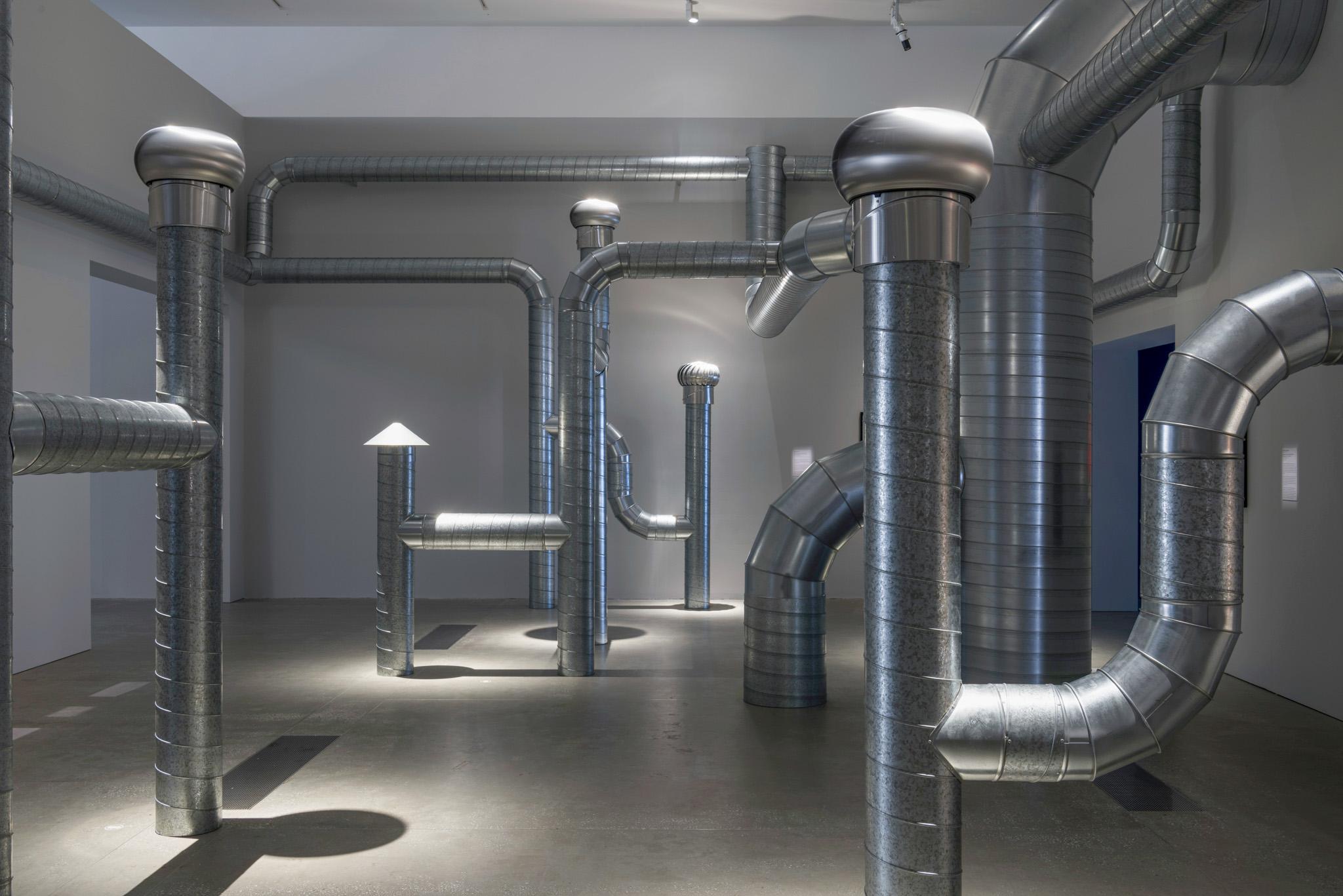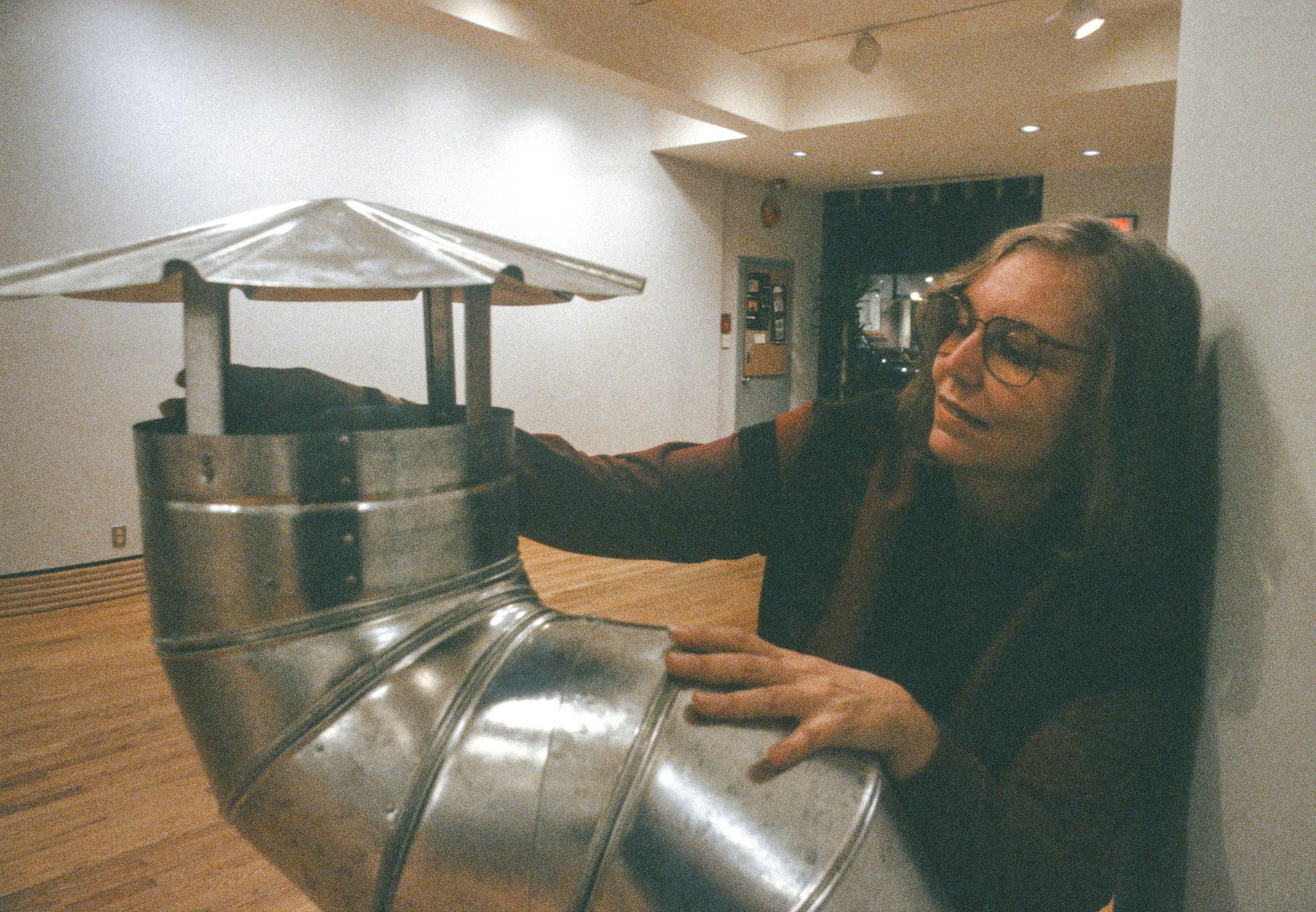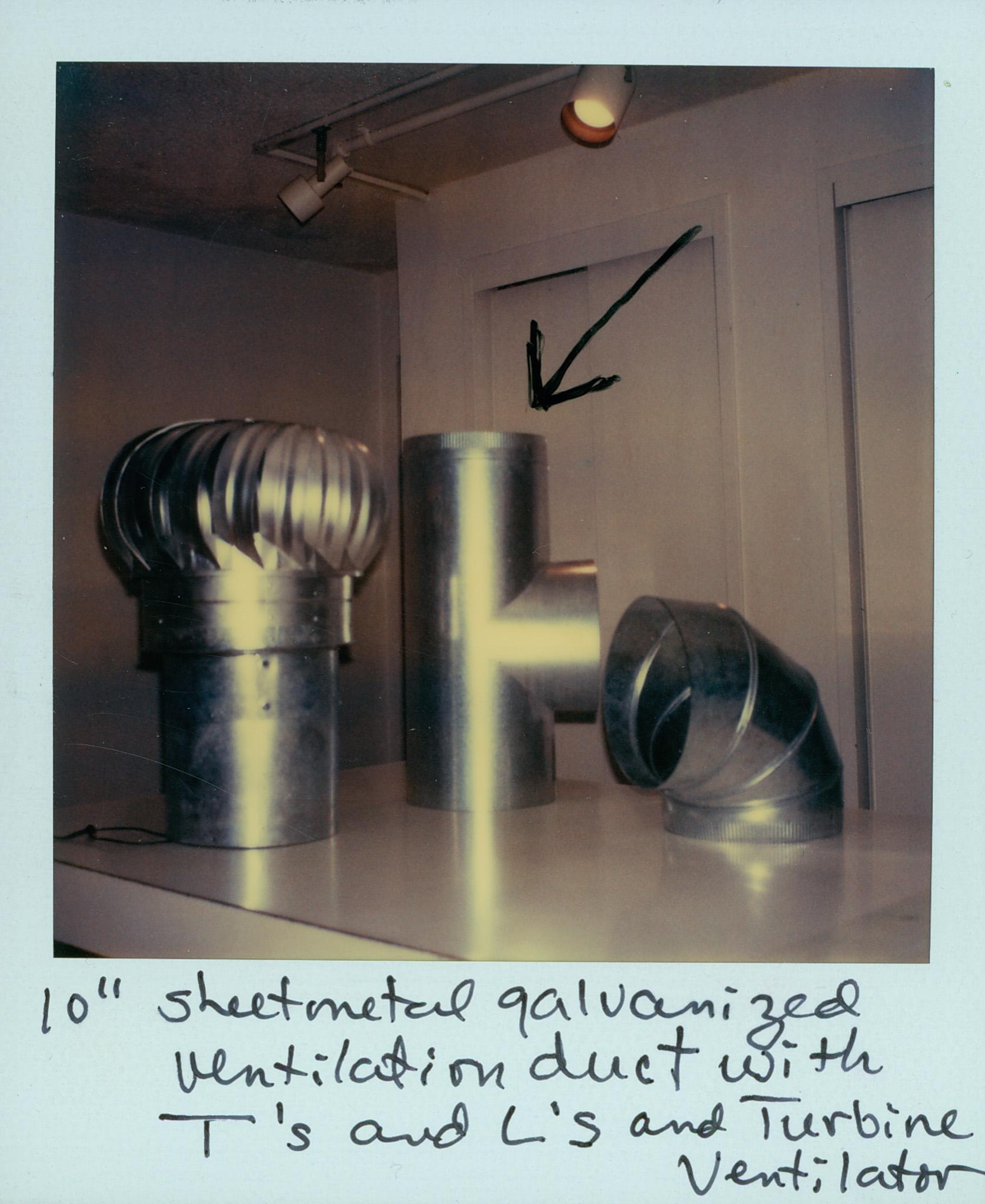Articulations of Air: the pneumatic aesthetics of Nancy Holt’s "Ventilation System"
In 1963, in the aftermath of her parents’ death, Nancy Holt experienced what she would later recall as a profound and lasting shift in perception: “There was a sudden moment out of time, or a timeless moment within time, when I had tremendous stillness and clarity. My body relaxed and my breathing came from a center which felt endlessly spacious. With every breath I was aware of sharing air, like an atmospheric bellows, with all the other beings on the planet.”1 That same year, the United States introduced the Clean Air Act—the first federal legislation regarding the monitoring and, crucially, the control of air pollution. It is perhaps not surprising that, at a moment when the growing threat to air purity was beginning to cause nationwide alarm, Holt—a biology major—should be so struck by our shared reliance on it, though it would be another two decades before her vision of an “atmospheric bellows” would find sculptural form.
Pages of the artist’s journal from 1992 show the ideas circulating around Ventilation System, with breath as a formative impulse. In a list of word associations that are variously playful, poetic and political, Holt connects breath with air, atmosphere, circulation and pollution, visualizing a vital interconnected system operating on a planetary scale: “Take a deep breath. Oxygen. Hydrogen. And now, as of yesterday, nuclear fall-out from Russia … Our atmosphere is finite… the windpipe as metaphor—as the body breathes, so the building breathes, so the world breathes.”2 The pneumatic sculptural network that had emerged prior to these musings would become a key work in Holt’s oeuvre. Ventilation System comprises an armature of industrial piping that crisscrosses the space, wrapping around the architecture and appearing to plumb into the walls and floor. A first encounter suggests you have inadvertently wandered into a back-of-house area of the museum, the plainly utilitarian language of the work distancing it from conventional sculpture. At points, the interconnected lengths of stainless-steel ducting are punctuated by a shanty cap or spinning vent. Up close it becomes clear the structure is channeling air—that most evanescent of substances, and a material Holt lists, like any other, in the caption for the work. As the turbines spin, their silvery blades catch the light, and the work comes to life—its unabashed functionality made wondrous by its unexpected presence in the gallery.
First conceived in 1985, Ventilation System belongs to Holt’s System Works, a body of site-specific artworks that externalize the hidden technological infrastructure we rely upon for our everyday existence. Usually found underground, above the ceiling, within the interstitial spaces of buildings or, as Holt remarks, “relegated to the realm of the unconscious,” these conduit systems are brought out into plain sight by the artist, who seeks to make a virtue of their humble operation.3 They reflect the artist’s longstanding interest—first explored through works from the early 1970s such as the Locators and California Sun Signs 1972—in taking aspects of the quotidian and deliberately dislocating or displacing them in ways which open up new avenues to our apperception. Espousing a truth to materials, the System Works are fabricated from standard components, whether plumbing, heating, electrical, ventilation or waste removal, and follow their prescribed purpose, with Holt noting how “they are part of open-ended systems, part of the world.”4 The massive steely contortions of Ventilation System, then, give visible form to the air that already circulates, almost imperceptibly, throughout our built environment. As we move through the installation, our awareness of the network’s unseen potential is heightened by the gusts of air that punctuate it at different junctures, an interactive dimension that Holt welcomes: “I like the idea of potential participatory involvement; I think it increases the sensation of the elements flowing through the work.”5
Like the other System Works, Ventilation System is modular and iterative, conceived by the artist as site-responsive, rather than site-specific. The four versions of the work made during Holt’s lifetime each possess their own unique character, shaped by the particularities of site and context, their opportunities and practicalities. In each configuration, the artist worked with local Heating, Ventilation, and Air Conditioning (HVAC) technicians to tie the work as closely as possible to existing ventilation systems within the building, mimicking their logic and continuing the impression of air flow, either between rooms or from indoors to outdoors. She notes in the aforementioned journal, with some pride, that the System Works are “all done to code—exactly the way you would do any functioning electrical or plumbing system.”6 At the same time, Holt brings a sculptor’s sensibility and intuition to bear on her staging of Ventilation System, “bending pipes in unusual ways and twisting them around on themselves.”7 In photographs taken of the artist installing the work, her regard for the engineering and unassuming utility of the various components is immediately apparent in the care with which she handles them. It is also mirrored in the precise way she inventories the parts—"pipes, shanty caps, T connections, square angles, fans” etc.—often recording the details of the manufacturer.8
While Holt’s journal reveals her desire to “replace stuffy museum air with fresh air,” this is, in part, metaphorical in intention—a balance is necessarily struck between function and fiction in Ventilation System, with some conduits actually penetrating the wall to allow fresh air in, and others only simulating it.9 Holt acknowledges this dramatic turn, born of the incorporation of elements which, while in fact redundant, look operational: “I intend the work to be practical yet playful, functional yet not really necessary.”10 She cultivates a deliberate contradictory tension between utility and absurdity which distinguishes Ventilation System from other System Works such as Electrical System (1982) and Heating System (1984) with their stricter functional application.11
Ventilation System—and, indeed, the whole body of System Works—developed from Holt’s longstanding meditations on energy, elemental dynamics and the finitude of the Earth’s resources. The startling clarity of their premise—a lens brought to something which is too often and too easily overlooked—finds a precursor in the artist’s iconic Land Art work Sun Tunnels (1973-76), which illuminates the macroscopic architecture of the solar system. Both serve as an apparatus for perception, casting these elemental systems anew and prompting us to reflect on our total, unquestioning dependence on them. With their different arrangements of pipes, the System Works also share other formal symmetries with the Sun Tunnels; circles, cylinders and tunnels being widely recognized as a foundational cornerstone within Holt’s practice.12
Posthumous presentations of Ventilation System have required some extrapolation of the artist’s ideas within the parameters and principles she established over the four versions of the work she created between 1985 and 1992. While the early environmental consciousness that shaped the System Works from their conception in 1982 remains central, certain curatorial assumptions must be made today in order to address questions of architectural specificity, technological obsolescence, geographical differences, changing attitudes to energy conservation, and other unforeseen challenges that arise when mounting the work. Holt’s own practice of making fluid and intuitive decisions on-site supports these future evolutions, ensuring Ventilation System continues to resonate as a living, breathing system into the twenty-first century.13 With the System Works, Holt sounded a clarion call for us to become “nature’s agents rather than nature’s aggressors,” driven by a belief that “while continuing to meet our immediate material needs, the channeling of energy and elements of the earth can be done intelligently with the long-term benefit of the planet in mind.”14 In our current moment of ecological crisis, when air no longer seems like an inexhaustible resource and when the “long-term benefit” of the planet is so catastrophically in question, Ventilation System assumes a new urgency. In recent iterations of the work, realized amidst both a global airborne pandemic (COVID-19) and increasingly imperative conversations about air pollution, air quality, and climate change, the sense of an ever-growing threat suffuses Holt’s atmospheric bellows—a threat felt, more keenly than ever, in its stirring articulations of air.
Selected Bibliography
Nancy Holt, private journals; Nancy Holt Estate Records, Archives of American Art, Smithsonian Institution
Leigh A. Arnold (ed.), Groundswell: Women of Land Art, Nasher Sculpture Center, Dallas, Texas, and DelMonico Books, New York, 2023
Nancy Holt, “Nancy Holt, Ventilation Series I-IV”, Sightlines, ed. by Alena J. Williams, University of California Press, 2011
Pamela M. Lee, “Art as a Social System: Nancy Holt and the Second-Order Observer”, Sightlines, ed. by Alena J. Williams, University of California Press, 2011
Lucy Lippard, “Tunnel Visions: Nancy Holt’s Art in the Public Eye” Sightlines, ed. by Alena J. Williams, University of California Press, 2011
James Meyer, “Interview with Nancy Holt”, Sightlines, ed. by Alena J. Williams, University of California Press, 2011
Joan Marter, “Systems – A conversation with Nancy Holt”, in sculpture journal, October 2013, vol. 32, no. 8
About the Author
Nina Miall is Curator, International Art at the Queensland Art Gallery / Gallery of Modern Art (QAGOMA) in Brisbane, Australia. Primary among her curatorial concerns are socially engaged, interdisciplinary and site-specific practices, which she has explored in exhibitions she has curated in Europe, the US, Asia, and Australia. She included Holt’s Ventilation System (its second posthumous presentation) in a thematic exhibition "Air" that she co-curated for GOMA in 2022-23. She has mounted several large-scale surveys of Australian art, including the 2021 TarraWarra Biennial and The National 2017 for Carriageworks, Sydney. She holds a B.A. from the University of Sydney and an M.A. from the Courtauld Institute of Art, London.
With support from Henry Luce Foundation
This Scholarly Text is supported by a grant from the Henry Luce Foundation to further our public-facing research into the art and ideas of Nancy Holt.
- 1James Meyer, “Interview with Nancy Holt”, Sightlines, ed. by Alena J. Williams, (University of California Press, 2011), 220.
- 2Nancy Holt’s journal—titled “Ventilation IV”, dated “Tampere, Wednesday March 25, 10pm.” Nancy Holt Estate Records, Archives of American Art, Smithsonian Institution; journal dated 1992 by the artist.
- 3Nancy Holt, “Nancy Holt, Ventilation Series I-IV”, Sightlines, ed. by Williams, Alena J. (University of California Press, 2011), 144.
- 4Holt, “Nancy Holt, Ventilation Series I-IV”, Sightlines, 144.
- 5Joan Marter, “Systems—A conversation with Nancy Holt”, sculpture journal, October 2013, vol. 32, no. 8, 31.
- 6Marter, “Systems—A conversation with Nancy Holt”, sculpture, 32.
- 7Marter, “Systems—A conversation with Nancy Holt”, sculpture, 31.
- 8See Holt’s annotated Polaroid titled “Turbine Ventilator with Fan” illustrated above.
- 9Ventilation III: Finn Air 1992, realized at the Tampere Art Museum in Finland, physically connects the outside and the inside, whereas this is only implied in Ventilation IV: Hampton Air 1992, created for the Guild Hall Museum in East Hampton, NY.
- 10Holt, “Nancy Holt, Ventilation Series I-IV”, Sightlines, 144.
- 11Joan Marter has commented on the perceived functionality of Ventilation System, relating it to Eva Hesse’s notion of the “absurd” in art. (Marter, “Systems—A conversation with Nancy Holt”, sculpture, 31.)
- 12Lucy Lippard, “Tunnels Visions: Nancy Holt’s Art in the Public Eye”, Sightlines, ed. by Alena J. Williams, (University of California Press, 2011), 68.
- 13Curators navigating a posthumous presentation of Holt’s work are also ably guided by both Holt’s journal and the expert assistance of the Holt/Smithson Foundation.
- 14Holt, “Nancy Holt, Ventilation Series I-IV”, Sightlines, 144.
Miall, Nina. "Articulations of Air: the pneumatic aesthetics of Nancy Holt’s Ventilation System." Holt/Smithson Foundation: Scholarly Texts Chapter 8 (August 2025). https://holtsmithsonfoundation.org/articulations-air-pneumatic-aesthetics-nancy-holts-ventilation-system.




